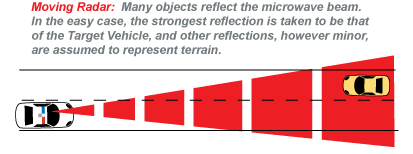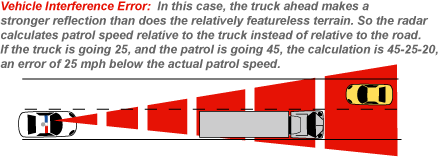Police Traffic Radar Errors
In court, radar suppliers and radar enforcers raise their right hands and swear that police radar never makes mistakes. If you have a radar ticket, you’re guilty.
But when the court is in recess and those same radar suppliers are pitching new equipment to those same enforcers, you hear a different story. Kustom Signals, Inc., of Lenexa, Kansas, has been making speed radars for about 50 years. In touting its TruTrak feature, Kustom says “…TruTrak eliminates common speed anomalies such as combined speeds, splitting speeds and shadowing.”
“Anomalies” is the salesman’s term for “errors.”
The errors Kustom admits to are as old as moving radar itself. In a test of radar units in 1980, the National Highway Traffic Safety Administration identified “shadowing” as a common problem with moving radars. A few years later, the Texas Department of Public Safety produced a comprehensive training manual in which it warned of “Vehicle Interference Error,” an umbrella category that includes “shadowing” and other errors.

Moving radar is much more complicated than stationary radar, which needs only to read moving targets within range. Moving radar must make two measurements, the relative speed between the target vehicle and the moving patrol car, and the actual patrol-car speed. It then calculates the target vehicle’s speed by adding to or subtracting from the patrol-car speed. If you’re thinking this process is subject to lots of electronic confusion, you’re absolutely right.
Originally, moving radar worked only on oncoming traffic, and it erred in that simple job. In the last 20 years, the addition of “same lane” capability gives readings on vehicles moving in the same direction as the patrol car. They can be either ahead of the patrol car or behind, which multiplies hugely the possibilities for error.
No matter whether the target is oncoming or traveling in the same direction, it can be clocked accurately only if the radar gets a correct reading on the patrol-car’s speed. “Vehicle Interference Errors” including “shadowing” all result from the wrong reading for patrol speed. For example, as moving radar looks for reflections from terrain that would allow it to calculate patrol speed, it sometimes grabs on to the stronger reflection from, say, the back of a truck moving in traffic. If the patrol car is moving at 45 mph, and the truck at 25, the radar calculates the patrol speed relative to the truck instead of the ground. It wrongly decides the patrol speed is 20 mph.

Let’s say the target car is also approaching at 45 mph in the oncoming lane. The radar correctly reads the relative speed between it and the patrol car as 90 mph, then subtracts the erroneous patrol speed of 20 mph, and pops up a target speed of 70. The red lights flash on and the unlucky motorist gets nailed for 25 mph over his actual speed.
Other common radar errors identified by the Texas Department of Public Safety include: Antenna positioning error; Look-past error; Cosine error; Double-bounce error; Beam-reflection error; Road-sign error; Radio-interference error; and Fan-interference error.
Perhaps Kustom really has eliminated some of radar’s errors as it claims. But what about all of those older Kustom units still in service, still bearing false witness against the innocent?
